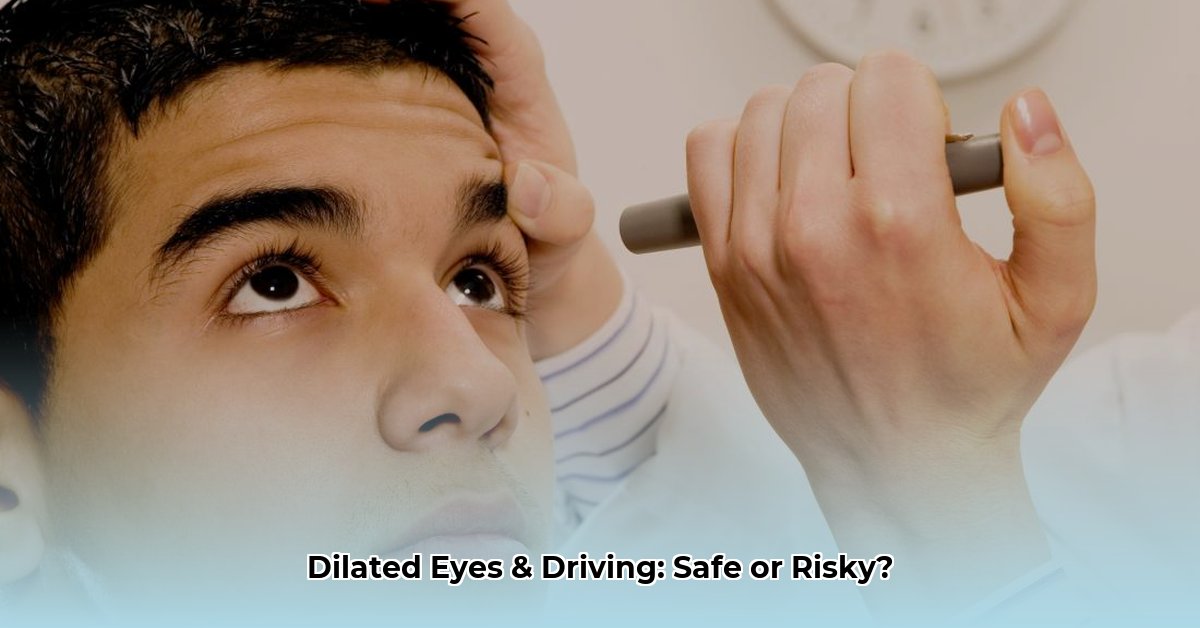Heading to the eye doctor? If you’re getting your eyes dilated, driving afterward is not recommended. Dilated eyes significantly impair vision, making it unsafe to drive. This article explains why driving with dilated eyes is dangerous, what happens during dilation, and how to ensure your safety and comfort before, during, and after your appointment. We’ll also cover alternative transportation options and answer common questions.
Understanding Eye Dilation
During dilation, eye drops widen your pupils, allowing your eye doctor a clearer view of your retina and optic nerve. This wider opening increases light entering your eyes, impacting vision afterward. You’ll likely experience blurred vision, especially up close, and increased light sensitivity. These effects typically last four to six hours, sometimes longer.
[Include an image here of a normal eye next to a dilated eye]
The Risks of Driving with Dilated Eyes
Driving with dilated pupils is strongly discouraged. It impairs your vision, making driving unsafe. Here’s why:
- Reduced Contrast Sensitivity: Dilated pupils make it harder to distinguish objects from their backgrounds, like reading road signs or seeing pedestrians at dusk.
- Difficulty Focusing: You might struggle to focus on things up close, like your dashboard, or switch focus between near and far objects, crucial for safe driving.
- Glare: Increased light sensitivity makes bright lights, like oncoming headlights, overwhelming and disorienting.
- Impaired Night Vision: Driving at night with dilated pupils is particularly dangerous due to increased glare and reduced contrast sensitivity.
- Slower Reaction Time: Difficulty focusing and increased glare can slow your reaction time, making it harder to respond to unexpected hazards.
These impairments increase the risk of accidents. Driving under these conditions could potentially have legal consequences similar to driving under the influence.
Preparing for Your Eye Exam: A Step-by-Step Guide
Before:
- Arrange Transportation: Ask a friend or family member for a ride, research public transportation, or book a ride-sharing service.
During:
- Bring Sunglasses: Sunglasses will help reduce light sensitivity after dilation.
- Wait: If possible, wait at the doctor’s office until the effects lessen.
After:
- Avoid Driving: Don’t drive until your vision returns to normal. Be aware of lingering effects, especially at night.
Transportation Alternatives
Consider these alternatives to driving:
- Friends/Family: Convenient and often free, but availability might be limited.
- Public Transportation: Cost-effective and environmentally friendly, but can be time-consuming and may not be accessible in all areas. Use online resources like [insert local public transportation website link] to plan your route.
- Ride-Sharing: Convenient and readily available, but costs can vary and surge pricing during peak hours can make it more expensive.
Managing Discomfort
- Sunglasses: Essential for minimizing light sensitivity.
- Hat: Offers extra protection from the sun.
- Indoor Rest: Stay indoors as much as possible until your vision improves.
- Eye Drops (if prescribed): While dilation typically wears off naturally, your doctor may suggest eye drops in some cases to help your pupils constrict. Always follow your doctor’s advice.
Frequently Asked Questions
- How long does dilation last? Typically four to six hours, but it can vary. Ongoing research suggests factors like age and medication can influence the duration.
- Is driving with dilated eyes illegal? While it might not be a specific offense everywhere, driving while visually impaired is illegal. Driving with dilated pupils could have legal ramifications similar to driving under the influence if it leads to an accident.
- Can I make dilation wear off faster? There’s no quick fix. Time is the primary factor. While some believe certain activities might help, scientific evidence is lacking. Always consult your doctor.
- What if I have an emergency and need to drive? Call 911. Explain your situation to the dispatcher, who can advise you on the best course of action.
Disclaimer
This information is for educational purposes only and is not medical advice. Consult a qualified eye care professional for any concerns about your eye health. Always follow your doctor’s instructions regarding eye dilation and driving.
- Shop Bento Box for Sale To Find Your Ideal Lunch Container - December 6, 2025
- Lunch Box That Fits Bento Box Neatly for Daily Use - December 5, 2025
- Japanese Lunch Bag Does Double Duty as Bento Carrier and Tote - December 4, 2025










